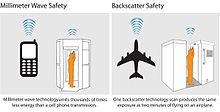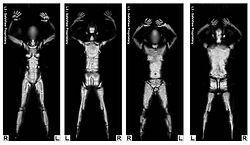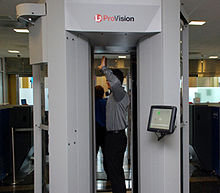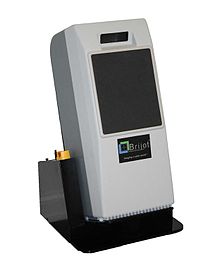- Millimeter wave scanner
-
 Active Millimeter Wave Unit
Active Millimeter Wave Unit
A millimeter wave scanner is a whole–body imaging device used for detecting objects concealed underneath a person’s clothing. Typical uses for this technology include detection of items for commercial loss prevention, smuggling and screening at government buildings and airport security checkpoints.
It is one of the common technologies of full body scanner used for body imaging; a competing technology is backscatter X-ray. Millimeter wave scanners themselves come in two varieties: active and passive. Active scanners direct millimeter wave energy at the subject and then interpret the reflected energy. Passive systems read only the raw energy that is naturally emitted from the human body or objects concealed on the body. The key difference is that passive systems direct no energy at the subject being screened and are as safe as a digital camera for both the screener and the subject.[1][2]
Several countries employ the scanners for security screening.[3] One of the most publicized millimeter-wave scanner systems is the Tadar system developed by Farran (now owned by Smiths Detection). The name "Tadar" was inspired by the Brazilian Tadarida bat.[4]
Contents
Technical details
Clothing and many other materials are translucent in some EHF (millimeter wave) radio frequency bands.[5] This frequency range is just below the (related) sub-millimeter terahertz radiation (or "T-ray") range.
With active scanners, the millimeter wave is transmitted from two antennas simultaneously as they rotate around the body. The wave energy reflected back from the body or other objects on the body is used to construct a three-dimensional image, which is displayed on a remote monitor for analysis.[1][2][3]
Privacy concerns
Privacy advocates are concerned about the use of active millimeter wave technology because it effectively implements routine and, in many cases, mandatory virtual strip searches. It allows screeners to see the surface of the skin under clothing, prosthetics including breast prostheses, and other medical equipment normally hidden, such as colostomy bags.[6] Passive millimeter wave devices do not have the same privacy concerns because the images produced with passive screening technology expose no anatomical details.[1][2]
While the radiation itself cannot distinguish between private and non-private areas, software imaging technology can mask specific body parts.[3] Proposed remedies for privacy concerns include scanning only people who are independently detected to be carrying contraband, or developing technology to mask genitals and other private parts. In some locations, travelers have the choice between the body scan or a traditional "patdown". In locations such as the UK, the scans are mandatory.[7][8]
In the United States, the Transportation Security Administration (TSA) claimed to have taken steps to address privacy objections. TSA claimed that the images captured by the machines were not stored. Despite this the U.S. Marshals Service admitted that it had saved thousands of images captured from a Florida checkpoint.[9] The officer sitting at the machine does not see the image; rather that screen shows only whether the viewing officer has confirmed that the passenger has cleared. Conversely, the officer who views the image does not see the person being scanned by the device.[10] In some locations, updated software has removed the necessity of a separate officer in a remote location. These units now generate a generic image of a person, with specific areas of suspicion highlighted by boxes. If no suspicious items are detected by the machine, a green screen instead appears indicating the passenger is cleared.
Concerns remain about alternative ways to capture and disseminate the image. Additionally, the protective steps often do not entirely address the underlying privacy concerns. Subjects may object to anyone viewing them in a state of effective undress, even if it is not the agent next to the machine, or even if the image is not retrievable.
Claims that images are immediately destroyed were questioned after Indian film star Shahrukh Khan joked that his image was circulated by airport staff at Heathrow in London. This comment appears to be a joke,[11] but reports of full-body scanner images being improperly and perhaps illegally saved and disseminated continue to emerge.[12]
Possible health effects
 The energy projected by millimeter wave technology is thousands of times less than a cell phone transmission. A single scan using backscatter technology produces exposure equivalent to two minutes of flying on an airplane, but delivered in several seconds.[13]
The energy projected by millimeter wave technology is thousands of times less than a cell phone transmission. A single scan using backscatter technology produces exposure equivalent to two minutes of flying on an airplane, but delivered in several seconds.[13]
Millimeter wave radiation is not genotoxic and cannot initiate cancer, unlike ionizing radiation such as high frequency ultraviolet and x-rays. While the majority of animal cancer studies show no response to chronic exposure to microwave radiation, some show an increased rate of tumor growth. The same increase also occurs in chronically–stressed animals not exposed to radiation.[14]
A study conducted by Boian S. Alexandrov and colleagues at the Center for Nonlinear Studies at Los Alamos National Laboratory in New Mexico[15] performed mathematical models how a different frequency region, terahertz (which are 10-100 times higher in frequency than millimeter wave radiation) interact with double-stranded DNA, showing that, even though involved forces seem to be tiny, nonlinear resonances (although much less likely to form than less-powerful common resonances) could allow terahertz waves to "unzip double-stranded DNA, creating bubbles in the double strand that could significantly interfere with processes such as gene expression and DNA replication".[16] Experimental verification of this simulation was not done. A recent analysis of this work concludes that the DNA bubbles do not occur under reasonable physical assumptions or if the effects of temperature are taken into account.[17]
Effectiveness
The efficacy of millimeter wave scanners in detecting threatening objects has been questioned. Formal studies demonstrated the relative inability of these scanners in detecting objects—dangerous or not—on the person being scanned.[18] Additionally, some studies suggested that the cost–benefit ratios of these scanners is poor.[19] As of January 2011, there had been no report of a terrorist capture as a result of a body scanner. In a series of repeated tests, the body scanners were unable to detect a handgun hidden in an undercover agent's undergarments.[20]
Deployment
While airport security may be the most visible and public use of body scanners, companies have opted to deploy passive employee screening to help reduce inventory shrink from key distribution centers.[21][22][23]
The UK Border Agency (UKBA) uses passive sceening technology to detect illicit goods.[24]
As of April 2009, the U.S. Transportation Security Administration began deploying scanners at airports, e.g., at the Los Angeles International Airport (LAX).[3] These machines have also been deployed in the Jersey City PATH train system.[25] They have also been deployed at San Francisco International airport (SFO), as well as Salt Lake International Airport (SLC) and Indianapolis International Airport (IND).
Three security scanners using millimeter waves were put into use at Schiphol Airport in Amsterdam on 15 May 2007, with more expected to be installed later. The passenger's head is masked from the view of the security personnel.
One is currently in use in London Luton airport.[26]
Passive scanners are also currently in use at Fiumicino Airport, Italy.[27] They will next be deployed in Malpensa Airport.[28]
The federal courthouse in Orlando, Florida employs passive screening devices capable of recording and storing images.
Canada
Kelowna International Airport in Kelowna, British Columbia hosted the first such device in a Canadian airport. It was pulled from service in 2008 for undisclosed reasons, but may have simply been a test unit on loan.[29]
Scanners are currently in use at Pearson Airport in Toronto, Ontario (YYZ), Montréal - Pierre Elliott Trudeau International Airport, Quebec (YUL), Calgary International Airport, Alberta (YYC), Vancouver International Airport, British Columbia (YVR), and Halifax Stanfield International Airport, Nova Scotia (YHZ).
The Canadian Air Transport Security Authority held a trial of the scanners at Kelowna International Airport in 2008. Before the trial, the Office of the Privacy Commissioner of Canada (OPCC) reviewed a preliminary Privacy Impact Assessment and CATSA accepted recommendations from the OPCC.[30] In October 2009, an Assistant Privacy Commissioner, Chantal Bernier, announced that the OPCC had tested the scanning procedure, and the privacy safeguards that CATSA had agreed to would “meet the test for the proper reconciliation of public safety and privacy”.[31] In January 2010, Transport Canada confirmed that 44 scanners had been ordered, to be used in secondary screening at eight Canadian airports.[32] The announcement resulted in controversies over privacy, effectiveness and whether the exemption for those under 18 would be too large a loophole.[33][34][35]
Other applications
Scanners can be used for 3D physical measurement of body shape for applications such as apparel design, prosthetic devices design, ergonomics, entertainment and gaming.
See also
- Backscatter X-ray (in security scanning applications)
- Explosives trace-detection portal machine (puffer machine)
- Full body scanner
- Security theater
- Electromagnetic radiation
- Extremely high frequency
- Microwave
References
- ^ a b c Mitchel Laskey (2010-03-17). "An Assessment of Checkpoint Security: Are Our Airports Keeping Passengers Safe?". House Homeland Security Subcommittee on Transportation Security & Infrastructure Protection. http://homeland.house.gov/SiteDocuments/20100317140311-88574.pdf.
- ^ a b c Matthew Harwood (2010-03-05). "Companies Seek Full-Body Scans That Ease Health, Privacy Concerns". Security Management. http://securitymanagement.com/news/companies-seek-full-body-scans-ease-health-privacy-concerns-006852.
- ^ a b c d TSA: Imaging technology
- ^ "Bat inspires space tech for airport security". European Space Agency. 2005-10-13. http://www.esa.int/esaCP/SEML1W5Y3EE_index_0.html. Retrieved 2011-02-05.
- ^ Scanner recognises hidden knives and guns - tech - 26 September 2006 - New Scientist Tech
- ^ "Privacy Impact Assessment for TSA Whole Body Imaging". http://www.dhs.gov/xlibrary/assets/privacy/privacy_pia_tsa_wbi.pdf. Retrieved 2009-10-19.
- ^ Pilots criticize security as Britain makes body scanners mandatory - News & Advice, Travel. The Independent (2010-02-02). Retrieved on 2010-09-26.
- ^ Lundin, Leigh (2010-08-15). "You show me yours and …". Florida News. Orlando: Criminal Brief. http://www.criminalbrief.com/?p=13511. "Remember Homeland Security told the public the scanners aren’t capable of storing images? Someone forgot to tell the scanner at the federal courthouse in Orlando…"
- ^ MSNBC (2010-08-04). "Police agencies admit to saving body scan images". http://www.msnbc.msn.com/id/38561251/ns/technology_and_science-security?GT1=43001. Retrieved 2010-08-10.
- ^ The Daily Telegraph (2008-10-24). "Airport body scanners 'will expose personal dignity'". London. http://www.telegraph.co.uk/travel/3252098/Airport-body-scanners-will-expose-personal-dignity.html. Retrieved 2010-01-03.
- ^ Shah Rukh Khan's body scanner image was not printed, says Heathrow Airport | Mail Online. Dailymail.co.uk (2010-02-10). Retrieved on 2010-09-26.
- ^ One Hundred Naked Citizens: One Hundred Leaked Body Scans | Gizmodo Gizmodo.com (2010-11-16). Retrieved on 2010-11-16.
- ^ TSA: Safety Advanced Imaging Technology
- ^ Ryan KL, D'Andrea JA, Jauchem JR, Mason PA (February 2000). "Radio frequency radiation of millimeter wave length: potential occupational safety issues relating to surface heating". Health Physics 78 (2): 170–81. PMID 10647983. http://meta.wkhealth.com/pt/pt-core/template-journal/lwwgateway/media/landingpage.htm?issn=0017-9078&volume=78&issue=2&spage=170. Retrieved 2010-08-28. "Thus, it is clear that RF radiation is not genotoxic and therefore cannot initiate cancer... the majority of such studies have shown that chronic exposure of animals to RF in the range of 435 to 2,450 MHz did not significantly alter the development of tumors in a number of animal cancer models... the same acceleration of skin cancer development and reduction in survival occurred in animals exposed to chronic confinement stress in the absence of RF exposure, suggesting that the RF effect could possibly be due to a non-specific stress reaction."
- ^ DNA Breathing Dynamics in the Presence of a Terahertz Field
- ^ How Terahertz Waves Tear Apart DNA
- ^ Modelling DNA Response to THz Radiation
- ^ German TV on the Failure of Full-Body Scanners
- ^ Why Europe Doesn't Want an Invasion of Body Scanners, news article
- ^ http://www.nbcdfw.com/news/local/TSA-Agent-Slips-Through-DFW-Body-Scanner-With-a-Gun-116497568.html
- ^ Jennifer Brown (2011-01-03). "The ROI for detection". Canadian Security. http://www.canadiansecuritymag.com/Access-Control/News/The-ROI-for-detection.html?pr.
- ^ Brendan Alexander (September 2008). "Streamlined Screening". Canadian Security. p. 26. http://cdnsecurity.clbmedia.dgtlpub.com/2008/2008-09-30/home.php.
- ^ Robert P. Daly (December 2008). "Facility Security:Security By The Layers". Security Products. p. 24. http://secprodonline.com/Issues/2008/December-2008.aspx.
- ^ Brodie Clark (Volume 16.10). "Securing the border". Government Business. p. 25. http://www.governmentbusiness.co.uk/content/view/1970/7/.
- ^ [1] Mirror for Star Ledger Article "PATH riders to face anti-terror screening — Program will begin at station in Jersey City" 2006/07/12 Wed Pg 014
- ^ More airports to use "whole body imaging" machines, CNN, April 15, 2005
- ^ La Repubblica. "Fiumicino, body scanners attivi da Giovedì 4 Marzo" (in Italian). http://roma.repubblica.it/dettaglio/fiumicino-body-scanner-attivi-da-giovedi-4-marzo/1870435. Retrieved 2010-03-05.
- ^ La Repubblica. "Terrorismo, sì dell'Italia ai body scanner - Frattini: "Sicurezza prima della privacy"" (in Italian). http://www.repubblica.it/2010/01/sezioni/esteri/terrorismo-usa/bodyscanner-italia/bodyscanner-italia.html. Retrieved 2010-01-05.
- ^ "Passengers virtually stripped naked by 3-D airport scanner". Canadian Broadcasting Corporation. 2008-06-20. http://www.cbc.ca/canada/british-columbia/story/2008/06/20/bc-virtually-naked-airport-scanner.html. Retrieved 2008-06-20.
- ^ Office of the Privacy Commissioner of Canada. "Report to Parliament 2008-2009 - Report on the Privacy Act". http://www.priv.gc.ca/information/ar/200809/200809_pa_e.cfm#toc4a2.
- ^ Bronskill, Jim (2009-10-30). "Privacy watchdog OKs 'naked' airport scanners". Toronto Star. http://www.thestar.com/travel/article/718598--privacy-czar-oks-see-through-airport-scanners. Retrieved 2010-01-08.
- ^ CBC News (2010-01-05). "Body scanners coming to Canadian airports". http://www.cbc.ca/canada/story/2010/01/05/security-canada-us-airport.html. Retrieved 2010-01-08.
- ^ "Airport scanners invade privacy: advocate". CBC News. 2010-01-05. http://www.cbc.ca/canada/british-columbia/story/2010/01/05/bc-airport-scanners-civil-liberties-vonn.html. Retrieved 2010-01-08.
- ^ The Canadian Press (2010-01-05). "Airport scanner announcement ignites debate". CTV News. http://www.ctvbc.ctv.ca/servlet/an/local/CTVNews/20100105/bc_full_body_scans_100105/20100105/?hub=BritishColumbiaHome. Retrieved 2010-01-08.
- ^ Allison Jones (2010-01-06). "Security experts wary of Canada's airport scanner exemption for minors". Winnipeg Free Press. http://www.winnipegfreepress.com/canada/breakingnews/80854642.html. Retrieved 2010-01-08.
External links
Categories:- Measuring instruments
- Security technology
Wikimedia Foundation. 2010.



